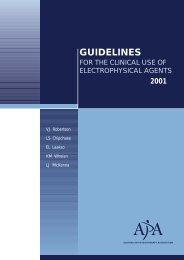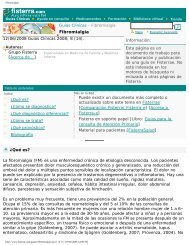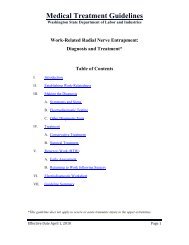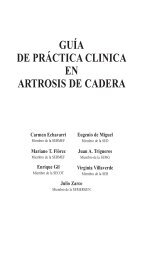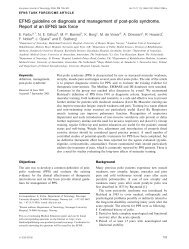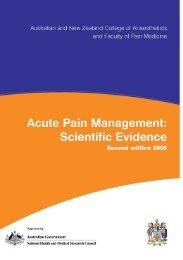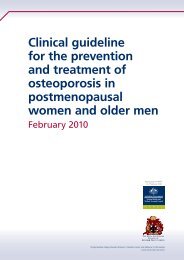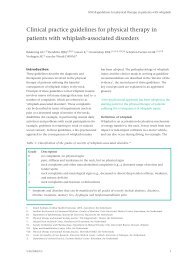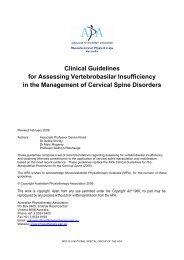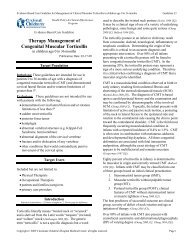EFNS guidelines on neurostimulation therapy for neuropathic pain
EFNS guidelines on neurostimulation therapy for neuropathic pain
EFNS guidelines on neurostimulation therapy for neuropathic pain
Create successful ePaper yourself
Turn your PDF publications into a flip-book with our unique Google optimized e-Paper software.
Neurostimulati<strong>on</strong> <strong>therapy</strong> <strong>for</strong> <strong>neuropathic</strong> <strong>pain</strong> 953are in progress in other movement and psychiatricdisorders, epilepsy and migraine. The neurostimulati<strong>on</strong>techniques proposed <strong>for</strong> treating <strong>pain</strong> are: transcutaneouselectrical nerve stimulati<strong>on</strong> (TENS), peripheralnerve stimulati<strong>on</strong> (PNS), nerve root stimulati<strong>on</strong> (NRS),spinal cord stimulati<strong>on</strong> (SCS), deep brain stimulati<strong>on</strong>(DBS), epidural motor cortex stimulati<strong>on</strong> (MCS), andrepetitive transcranial magnetic stimulati<strong>on</strong> (rTMS).These techniques vary greatly in their degree of invasiveness,stimulated structures and rati<strong>on</strong>ale, but theyare all adjustable and reversible.Our Task Force aimed at providing the neurologistwith evidence-based recommendati<strong>on</strong>s that may help todetermine when a patient with <strong>neuropathic</strong> <strong>pain</strong> shouldtry a neurostimulati<strong>on</strong> procedure. To provide a betterunderstanding, the results are preceded by a descripti<strong>on</strong>of the procedure and its supposed rati<strong>on</strong>ale.Search methodsTask Force participants were divided into subgroupsand assigned the search <strong>for</strong> specific neurostimulati<strong>on</strong>procedures, with two pers<strong>on</strong>s carrying out an independentsearch <strong>for</strong> each procedure. A two-stage approachto the relevant literature search wasundertaken. First the MEDLINE, EMBASE andCochrane databases were searched <strong>for</strong> systematic reviews,from incepti<strong>on</strong> date to May 2006. Detailedsearches are listed in Appendix 1 (SupplementaryMaterial). Recent textbooks known to the authorswere also examined <strong>for</strong> relevant references. These reviewsand books were used to identify the primaryliterature. Sec<strong>on</strong>dly, given the search cut off dates ofprevious systematic reviews, an update search <strong>for</strong>primary studies (randomized c<strong>on</strong>trolled trials, n<strong>on</strong>randomizedc<strong>on</strong>trolled trials, observati<strong>on</strong>al comparativestudies and case series) was undertaken. Studiesidentified by this updated search were added to thebody of evidence <strong>for</strong> each neurostimulati<strong>on</strong> procedureunder each indicati<strong>on</strong> heading.All study designs were included except case reportsand very small case series (
Neurostimulati<strong>on</strong> <strong>therapy</strong> <strong>for</strong> <strong>neuropathic</strong> <strong>pain</strong> 955Table 1 Summary of efficacy and safety of peripheral stimulati<strong>on</strong>s (TENS, PNS, and NRS)Technique/c<strong>on</strong>diti<strong>on</strong> Available evidenceNo.patients Summary of efficacyTENS/chr<strong>on</strong>ic<strong>pain</strong>TENS/NePPainful diabeticneuropathyOne meta-analysis [10],analysing 38 RCTs;<strong>on</strong>ly two <strong>on</strong><strong>neuropathic</strong><strong>pain</strong>: Thorsteinss<strong>on</strong>1977 and Rutgers1988 [16,17]– There is no evidence; butit is clear that effectincreases with dose(durati<strong>on</strong> of the sessi<strong>on</strong>· frequency ofsessi<strong>on</strong>s · total durati<strong>on</strong>)Reichstein 2005 [11] 25 TENS compared with HFmuscle: 25% success withTENS and 69% with HFDiabeticneuropathyPainful diabeticneuropathyDiabeticneuropathyTraumaticneuropathyForst 2004 [14] 19 LF TENS reduced VAS by23%, significant differencefrom placeboHamza 2000 [13] 50 Painful PENS reduced VASby 60%, significantdifference from sham, andimproved QoLKumar 1997 [12] 35 LF TENS with biphasicstimuli exp<strong>on</strong>entiallydecaying was significantlybetter than sham inreducing <strong>neuropathic</strong>symptomsCheing 2005 [15] 19 Significantly better thanplaceboRadiculopathy Bloodworth 2004 [18] 11 Random TENS and TENS<strong>on</strong> the cervical back weresignificantly better thanplacebo, with R-TENSbetter than TENSMixed <strong>pain</strong>s CT Tulgar 1991(internal c<strong>on</strong>trol)8 Two did not get sufficient<strong>pain</strong> relief; <strong>on</strong>e receivedprol<strong>on</strong>ged<strong>pain</strong> relief; three wentbetter with ÔburstÕ, <strong>on</strong>ewith high-rate and <strong>on</strong>ewith low-ratemodulated TENSSummary ofharms Comparator Blind Random<str<strong>on</strong>g>EFNS</str<strong>on</strong>g>class CommentsPracticallynothingVarious Yes Yes IPracticallynothingPracticallynothingHigh-frequencymuscle stimulati<strong>on</strong>Yes Yes II Reichstein [11] has noplacebo, TENS goesfar worse than HFmuscle stimulati<strong>on</strong>Placebo Yes Yes IIIPracticallynothingSham Yes III Crossover with aninadequate comparator(needles with no current)PracticallynothingSham Yes III Sham inadequate andreport of improvementof allsymptoms.PracticallynothingPracticallynothingPlacebo Yes Yes IIPlacebo andRandom-TENSYes Yes III Few patients andcrossoverPracticallynothingFour modes ofTENSstimulati<strong>on</strong>Yes No IV Few patients who chosewhich mode of TENSthey preferredÓ 2007 <str<strong>on</strong>g>EFNS</str<strong>on</strong>g> European Journal of Neurology 14, 952–970
956 G. Cruccu et al.Table 1 (C<strong>on</strong>tinuted)Technique/c<strong>on</strong>diti<strong>on</strong> Available evidenceNo.patients Summary of efficacySummary ofharms Comparator Blind Random<str<strong>on</strong>g>EFNS</str<strong>on</strong>g>class CommentsPHN RCT Rutgers 1988[17]PeripheralneuropathyRCT Thorsteinss<strong>on</strong>1977 [16]few Practicallynothing24 Significantly better thanplaceboPracticallynothingAcupuncture See McQuayet al. 1997 [10]Placebo Yes Yes IIIPNS/NeP No meta-analyses, noRCTsCRPS II Buschmann 1999 52 Successful in 47Peripheral (n) Nashold 1982 35 Successful in 15Post-traumatic Law 1980 22 Successful in 13Mixed/various Picaza 1977 37 Successful in 18Mixed/various Campbell 1976 33 Successful in eightPeripheral (n)radiculopathy,amputati<strong>on</strong>Picaza 1975 23 Successful in 20Totals 202 Successful in 121 (60%)Sometimesneed <strong>for</strong>reoperati<strong>on</strong>N<strong>on</strong>e No No Class IV notenoughevidence<strong>for</strong> anyrecommendati<strong>on</strong>Very few and oldpapers, thistechnique does notseem to be gettingpopularNRS/NeP No meta-analyses,no RCTsNeuropathicpelvic <strong>pain</strong>InterstitialcystitisCT Everaert 2001 26 Successful in 16Whitmore 2003,no c<strong>on</strong>trol33 Significant improvementSometimesneed <strong>for</strong>reoperati<strong>on</strong>N<strong>on</strong>e No No Class IV notenoughevidence<strong>for</strong> anyrecommendati<strong>on</strong>TENS, transcutaneous electrical nerve stimulati<strong>on</strong>; LF TENS, low-frequency, high-intensity TENS, also called acupuncture-like; PNS, peripheral nerve stimulati<strong>on</strong> with implanted electrodes; NRS,nerve root stimulati<strong>on</strong> with implanted electrodes; QoL, quality of life; CT, c<strong>on</strong>trolled trial; HF, high frequency; PENS, percutaneous electrical nerve stimulati<strong>on</strong>.Ó 2007 <str<strong>on</strong>g>EFNS</str<strong>on</strong>g> European Journal of Neurology 14, 952–970
Neurostimulati<strong>on</strong> <strong>therapy</strong> <strong>for</strong> <strong>neuropathic</strong> <strong>pain</strong> 959Table 2 (C<strong>on</strong>tinued)Indicati<strong>on</strong>Volume of evidence[no. trials (no.patients)]Diabetic neuropathy One prospective caseseries [n ¼ 8]Tesfaye et al. 1996;Daousi et al. 2004One retrospectivemixed case series[n ¼ 14]Kumar et al. 2006Other peripheral neuropathy One retrospectivemixed case series[n ¼ 23]Kim et al. 2001Post-herpetic neuralgia Four retrospectivecase series (3 mixed)[10; 28; 8; 4 (50)]Kumar et al. 2006;Harke et al. 2002;Meglio et al. 1989;Sanchez-Ledesmaet al. 1989Intercostal neuralgia No evidence foundrelating to thisspecific diagnosisBrachial plexus damage/avulsi<strong>on</strong> Two retrospectivecase series (2 mixed)[8; 8 (16)]Simps<strong>on</strong> et al. 2003Hood; Siegfried 1984<str<strong>on</strong>g>EFNS</str<strong>on</strong>g>class Summary of efficacy Summary of harms<str<strong>on</strong>g>EFNS</str<strong>on</strong>g>grade CommentsIVIVPain relief>50% <strong>pain</strong> relief in6/8 at 14 m<strong>on</strong>ths(6/7: <strong>on</strong>e died at2 m<strong>on</strong>ths)>50% relief in 5/6 at3 years (backgroundand peak <strong>pain</strong>)>50% relief in 4/4 at7 years (background<strong>pain</strong>)>50% relief in 3/4 at7 years (peak <strong>pain</strong>)Exercise toleranceIncreased by 150%in 6/6Pain relief>50% relief in 12/14Ôl<strong>on</strong>g-termÕIV Pain relief>50% relief in 10/23(43.5%) at 1 yearLead migrati<strong>on</strong> in 2/8Superficial infecti<strong>on</strong> in 2/8Skin reacti<strong>on</strong> in 1/8Not disaggregated DD Prospective VAS + McGillSep. <strong>pain</strong> elementsPreservati<strong>on</strong> of large fibre(vibrati<strong>on</strong> and jointpositi<strong>on</strong>) functi<strong>on</strong> essentialFive outcome measuresThird party assessorFollow-up unclearIV Pain reliefSignificant l<strong>on</strong>g-termin 38/50 (pooled)Medicati<strong>on</strong> stopped in21/31Opioids stopped in18/19Lead fracture in <strong>on</strong>eReceiver failure in <strong>on</strong>eLeads replaced in three toimprove coverageD Success varies between seriesdue to variabledeafferentati<strong>on</strong>IV Pain reliefSignificant relief in8/16Nil, or not disaggregated D Different scoring methodsEvidence of full avulsi<strong>on</strong>(cf damage) of specificrelevant nerve roots notalways givenÓ 2007 <str<strong>on</strong>g>EFNS</str<strong>on</strong>g> European Journal of Neurology 14, 952–970
960 G. Cruccu et al.Table 2 (C<strong>on</strong>tinued)Indicati<strong>on</strong>Volume of evidence[no. trials (no.patients)]<str<strong>on</strong>g>EFNS</str<strong>on</strong>g>class Summary of efficacy Summary of harms<str<strong>on</strong>g>EFNS</str<strong>on</strong>g>grade CommentsAmputati<strong>on</strong> <strong>pain</strong>(phantom and stump)Three retrospectivecase series[25; 9; 61 (95)]Lazorthes et al. 1995;Simps<strong>on</strong> 1991Krainick + Thoden1989; Krainick et al.1975Facial <strong>pain</strong> (trigeminopathic) Insufficient evidenceCentral <strong>pain</strong> ofFive retrospective casespinal cord originseries (4 mixed) [19;11; 101; 9; 35 (175)]Kumar et al. 2006;Barolat et al. 1998;Lazorthes et al.1995; Ci<strong>on</strong>i et al.1995; Meglio et al.1989; Tasker et al.1992Central <strong>pain</strong> of brain origin Two retrospectivecase series (1 mixed)[45; 10 (55)]Katayama et al. 2001;Simps<strong>on</strong> 1991 [39]IV Phantom <strong>pain</strong>Significant relief in 7/14Stump <strong>pain</strong>Significant relief in 5/9Mixed – stump/phantom notspecifiedKrainick’s series: 56% of 61 had>50% relief (early), droppingto 43% (late). Reduced drugintake correlatedLazorthes: 60% of 25 good orexcellent l<strong>on</strong>g-term (‡2 years)IV Pain reliefa) cord injury: 15/62 significantl<strong>on</strong>g term <strong>pain</strong> relief overallincomplete: 11/33 significantreliefcomplete: 0/11 significant reliefb) MS: l<strong>on</strong>g-term <strong>pain</strong> relief <strong>on</strong>five outcome measures in 15/19(Kumar)bowel/sphincter functi<strong>on</strong>improved in 16/28Gait improved in 15/19(no details)c) mixed incl trauma, tumoursurgery, viral etc: 34% good/excellent at ‡2 years (Lazorthes;n ¼ 101). Pain relief, analgesicdrug intake and activityIV Pain reliefSignificant in 6/55>60% reducti<strong>on</strong> in VAS in 3/45Infecti<strong>on</strong> 1.6%Surgical revisi<strong>on</strong>s 31%Not stated/not disaggregatedin four studiesAseptic meningitis 1/9Superficial infecti<strong>on</strong> 1/9Electrode dislodgement 1/9Not stated/not disaggregated DD Phantom and stump <strong>pain</strong>snot always distinguishedD Completeness of lesi<strong>on</strong> notalways statedMuch greater success whereclinically incomplete lesi<strong>on</strong>Success correlates withsensory status: the lesssensory deficit the better theresultsCMM, c<strong>on</strong>venti<strong>on</strong>al medical management; ODI, Oswestry Disability Index; SIP, sickness impact profile; VAS, visual analogue scale; HRQoL, health-related quality of life; NRS, numerical rating scale;MS, multiple sclerosis.Ó 2007 <str<strong>on</strong>g>EFNS</str<strong>on</strong>g> European Journal of Neurology 14, 952–970
Neurostimulati<strong>on</strong> <strong>therapy</strong> <strong>for</strong> <strong>neuropathic</strong> <strong>pain</strong> 961appropriate stimulati<strong>on</strong> cannot be achieved. However,this testing is not a guarantee of l<strong>on</strong>g-term success in<strong>neuropathic</strong> <strong>pain</strong>.Evidence identifiedWe identified a number of systematic reviews andmeta-analyses [20–22] and a few narrative but detailedreviews [23–25]. The majority of systematic reviews, aswell as primary studies, to date have focused <strong>on</strong>patients with failed back surgery syndrome (FBSS) orcomplex regi<strong>on</strong>al <strong>pain</strong> syndrome (CRPS). C<strong>on</strong>cerningFBSS there are two class-II RCTs, the first showingthat SCS is more effective than reoperati<strong>on</strong> [26] and thesec<strong>on</strong>d that its additi<strong>on</strong> is more effective than c<strong>on</strong>venti<strong>on</strong>almedical care al<strong>on</strong>e [27,28]. In these trials theresp<strong>on</strong>ders (<strong>pain</strong> relief >50%) to SCS were 47–48% vs.9–12% with comparator, at 6–24 m<strong>on</strong>ths. In the pooleddata from case series in 3307 FBSS patients, the proporti<strong>on</strong>of resp<strong>on</strong>ders was 62%. In CRPS type I, resultsand evidence level are also good, with a single class-IIRCT of SCS compared with c<strong>on</strong>venti<strong>on</strong>al care al<strong>on</strong>e[29,30]. In this RCT, SCS reduced the visual analoguescale score by a mean 2.6 cm more than comparator at6 m<strong>on</strong>ths and by 1.7 cm at 5 years. In the pooled datafrom case series (n ¼ 561) in CRPS I and II, the proporti<strong>on</strong>of resp<strong>on</strong>ders was 67%. Both RCTs and caseseries have also found significant improvement infuncti<strong>on</strong>al capacity and quality of life. In a pooledsafety analysis of SCS across all indicati<strong>on</strong>s, the undesiredevents were mostly dysfuncti<strong>on</strong> in the stimulatingapparatus: lead migrati<strong>on</strong> (13.2%), lead breakage(9.1%), and other minor hardware problems [20]. Alsothe medical complicati<strong>on</strong>s were minor and never lifethreatening and were usually solved, like the hardwareproblems, by removing the device. The overall infecti<strong>on</strong>rate was 3.4%.The effect of SCS has also been studied in many otherc<strong>on</strong>diti<strong>on</strong>s. We found positive case series evidence <strong>for</strong>CRPS II, peripheral nerve injury, diabetic neuropathy,PHN, brachial plexus damage, amputati<strong>on</strong> (stump andphantom <strong>pain</strong>s) and partial spinal cord injury, andnegative evidence <strong>for</strong> central <strong>pain</strong> of brain origin, nerveroot avulsi<strong>on</strong> and complete spinal cord transecti<strong>on</strong>.However, all reports are class IV, thus preventing anyfirm c<strong>on</strong>clusi<strong>on</strong>. The efficacy and safety outcomes ofSCS are detailed by indicati<strong>on</strong> in Table 2.Recommendati<strong>on</strong>sWe found level B evidence <strong>for</strong> the effectiveness of SCSin FBSS and CRPS I. The available evidence is alsopositive <strong>for</strong> CRPS II, peripheral nerve injury, diabeticneuropathy, PHN, brachial plexus lesi<strong>on</strong>, amputati<strong>on</strong>(stump and phantom <strong>pain</strong>s) and partial spinal cordinjury, but still requires c<strong>on</strong>firmatory comparative trialsbe<strong>for</strong>e the use of SCS can be unreservedlyrecommended in these c<strong>on</strong>diti<strong>on</strong>s.Deep brain stimulati<strong>on</strong>Deep brain stimulati<strong>on</strong> <strong>for</strong> the treatment of medicallyrefractory chr<strong>on</strong>ic <strong>pain</strong> preceded the gate theory [31].Deep brain targets in current use include the sensory(ventral posterior) thalamus and periventricular graymatter (PVG) c<strong>on</strong>tralateral to the <strong>pain</strong> if unilateral, orbilaterally if indicated. Both sites have been targets ofanalgesic DBS <strong>for</strong> three decades [32,33]. After accuratetarget localizati<strong>on</strong> using MRI, stereotactic computerizedtomography and brain atlas co-registrati<strong>on</strong> asappropriate, an electrode is stereotactically inserted intosubcortical cerebrum under local anesthesia. The electrodesare c<strong>on</strong>nected to a subcutaneous IPG, placed inthe chest or abdomen.The mechanisms by which DBS relieves <strong>pain</strong> remainunclear. Animal experiments have shown that thalamicstimulati<strong>on</strong> suppressed deafferentati<strong>on</strong> <strong>pain</strong>, mostprobably via thalamo-corticofugal descending pathways.Aut<strong>on</strong>omic effects of PVG stimulati<strong>on</strong> are underinvestigati<strong>on</strong>, a positive correlati<strong>on</strong> between analgesicefficacy and magnitude of blood pressure reducti<strong>on</strong>have been dem<strong>on</strong>strated in humans [34]. It is currentlybelieved that stimulati<strong>on</strong> of ventral PVG engages n<strong>on</strong>opioiddependent analgesia commensurate with passivecoping behaviour whereas stimulati<strong>on</strong> of dorsal PVGinvolves opioid-related Ôfight or flightÕ analgesia withassociated aut<strong>on</strong>omic effects [34]. The effect of frequency,lower frequencies (5–50 Hz) being analgesicand higher frequencies (>70 Hz) <strong>pain</strong>-provoking,suggests a dynamic model whereby synchr<strong>on</strong>ousoscillati<strong>on</strong>s modulate <strong>pain</strong> percepti<strong>on</strong>.As with any implanted technique of neurostimulati<strong>on</strong><strong>for</strong> treating <strong>pain</strong>, patient selecti<strong>on</strong> is a major challenge.Trial stimulati<strong>on</strong> via externalized leads can identifythose in whom DBS is not efficacious or poorly tolerated[35,36]. However, successful trial stimulati<strong>on</strong> hasnot resulted in l<strong>on</strong>g-term success <strong>for</strong> up to half of cases.C<strong>on</strong>traindicati<strong>on</strong>s include psychiatric illness, uncorrectablecoagulopathy, and ventriculomegaly precludingdirect electrode passage to the surgical target [37].Evidence identifiedWe identified several reviews and <strong>on</strong>e meta-analysis[37], which c<strong>on</strong>clude that DBS is more effective <strong>for</strong>nociceptive <strong>pain</strong> than <strong>for</strong> <strong>neuropathic</strong> <strong>pain</strong> (63% vs.47% l<strong>on</strong>g-term success). In patients with <strong>neuropathic</strong><strong>pain</strong>, moderately higher rates of success were seen inpatients with peripheral lesi<strong>on</strong>s (phantom limb <strong>pain</strong>,radiculopathies, plexopathies and neuropathies) [37].We identified a number of primary studies, <strong>for</strong> 623Ó 2007 <str<strong>on</strong>g>EFNS</str<strong>on</strong>g> European Journal of Neurology 14, 952–970
Neurostimulati<strong>on</strong> <strong>therapy</strong> <strong>for</strong> <strong>neuropathic</strong> <strong>pain</strong> 963Table 5 Summary of efficacy and safety of deep brain stimulati<strong>on</strong> by indicati<strong>on</strong> from other, older studies (after Bittar et al. 2005) [37]Indicati<strong>on</strong>Volume ofevidence(no. patients)Success <strong>on</strong> initialstimulati<strong>on</strong>Success <strong>on</strong> chr<strong>on</strong>icstimulati<strong>on</strong>L<strong>on</strong>g-termpercentage successAmputati<strong>on</strong> <strong>pain</strong>9 7 4 44(phantom and stump)Post-stroke <strong>pain</strong> 45 24 14 31FBSS 59 54 46 78Peripheral nerve injury 44 36 31 70Post-herpetic neuralgia 11 6 4 36Intercostal neuralgia 4 3 1 25Brachial plexus damage/avulsi<strong>on</strong> 12 9 6 50Malignancy <strong>pain</strong> 23 19 15 65Facial <strong>pain</strong> (trigeminopathic) 32 21 12 38Central <strong>pain</strong> of spinal cord origin 47 28 20 43Other 35 28 22 63Table 6 Summary of efficacy and anatomical targets from other, olderstudies (after Bittar et al. 2005 [5])Anatomical siteof DBSVolume ofevidence no.patientsNumbersuccessfull<strong>on</strong>g-termPVG 148 117 79PVG and55 48 87ST or ICST 100 58 58ST or IC 16 6 38PercentagesuccessPVG, periventricular gray matter; ST, sensory thalamus; IC, internalcapsule.c<strong>on</strong>comitant to MRI-guided Ôneur<strong>on</strong>avigati<strong>on</strong>Õ. Intraoperativecortical stimulati<strong>on</strong> with clinical assessmentor EMG recordings can help to determine the positi<strong>on</strong>of the electrodes. One or two quadripolar electrodes areimplanted over the motor representati<strong>on</strong> of the <strong>pain</strong>fularea, either parallel or orthog<strong>on</strong>al to the central sulcus.The electrode is c<strong>on</strong>nected to a subcutaneous IPG. Thestimulati<strong>on</strong> parameters are optimized post-operatively,keeping the intensity below motor threshold, and thestimulati<strong>on</strong> is usually set <strong>on</strong> cyclic mode (alternatingÔ<strong>on</strong>Õ and ÔoffÕ periods).The mechanism of acti<strong>on</strong> of MCS remains hypothetical.Tsubokawa et al. [40] showed that MCSattenuated abnormal thalamic hyperactivity afterspinothalamic transecti<strong>on</strong> in cats, and c<strong>on</strong>sidered thatsuch effect involved retrograde activati<strong>on</strong> of somatosensorycortex by cortico-cortical ax<strong>on</strong>s [41]. However,positr<strong>on</strong>-emissi<strong>on</strong> tomography and SEPs failed to showany significant activati<strong>on</strong> of sensory-motor cortex duringMCS, whilst a str<strong>on</strong>g focal activati<strong>on</strong> was observedin thalamus, insula, cingulate-orbitofr<strong>on</strong>tal juncti<strong>on</strong>and brainstem [42,43], suggesting that MCS-induced<strong>pain</strong> relief may relate to (i) top-down activati<strong>on</strong> ofdescending <strong>pain</strong> c<strong>on</strong>trol systems going from motorcortex to thalamus, and perhaps to motor brainstemnuclei and (ii) blunting of affective reacti<strong>on</strong>s to <strong>pain</strong> viaactivati<strong>on</strong> of orbitofr<strong>on</strong>tal-perigenual cingulate cortex[43]. Both hypotheses have received recent support fromstudies in animals and in humans [44–46]. The fact thatmany of the regi<strong>on</strong>s activated by MCS c<strong>on</strong>tain highlevels of opioid receptors suggests that l<strong>on</strong>g-lastingMCS effects may also involve secreti<strong>on</strong> of endogenousopioids.Eligible patients should be resistant or intolerant tomain drugs used <strong>for</strong> <strong>neuropathic</strong> <strong>pain</strong> [1,2]. Somestudies include pre-operative sessi<strong>on</strong>s of transcranialmagnetic stimulati<strong>on</strong>, which is regarded predictive ofthe MCS outcome (see Repetitive transcranial magneticstimulati<strong>on</strong>). Candidates to MCS have sometimesexperienced failure of other neurosurgical procedures,such as radicellectomy (DREZ-lesi<strong>on</strong>), anterolateralcordotomy, trigeminal nerve surgery or SCS.Evidence identifiedOur search disclosed no systematic review or metaanalysis,but found a relatively large number of studies(mostly case series) <strong>on</strong> CPSP and facial <strong>neuropathic</strong><strong>pain</strong>. In CPSP, we extracted 143 n<strong>on</strong>-overlapping patientsfrom 20 case series: the average proporti<strong>on</strong> ofsuccess was about 50%. Slightly better results (60% ofresp<strong>on</strong>ders, based <strong>on</strong> 60 patients from eight series)were obtained in facial <strong>neuropathic</strong> <strong>pain</strong>, central orperipheral. Most of these case series were class IV.Two studies can be classified as class III, because theyhad a comparator (results of other treatments, surgicalor pharmacological), and outcome assessment andtreatment were dissociated: Katayama et al. [39]. hada 48% success rate in patients with CPSP and Nutiet al. [4]. A 52% success rate in 31 patients with various<strong>neuropathic</strong> <strong>pain</strong> c<strong>on</strong>diti<strong>on</strong>s, mostly CPSP. Oneof these papers provided follow-up results up toÓ 2007 <str<strong>on</strong>g>EFNS</str<strong>on</strong>g> European Journal of Neurology 14, 952–970
964 G. Cruccu et al.4 years [4]. In phantom <strong>pain</strong>, brachial plexus or nervetrunk lesi<strong>on</strong>, spinal cord lesi<strong>on</strong>s or CRPS, we <strong>on</strong>lyfound case reports. Most comm<strong>on</strong> undesired eventswere related to some malfuncti<strong>on</strong> of the stimulatingapparatus (e.g. unexpected battery depleti<strong>on</strong>). Seizures,wound infecti<strong>on</strong>, sepsis, extradural haematoma,and <strong>pain</strong> induced by MCS have also been reported.Overall 20% of patients experience <strong>on</strong>e or morecomplicati<strong>on</strong>s, in general of benign nature. Details ofthe search with summary of benefits/harms can befound in Table 7 and 8.Recommendati<strong>on</strong>sThere is level C evidence (two c<strong>on</strong>vincing class IIIstudies, 15–20 c<strong>on</strong>vergent class IV series) that MCS isuseful in 50–60% of patients with CPSP and central orperipheral facial <strong>neuropathic</strong> <strong>pain</strong>, with small risk ofmedical complicati<strong>on</strong>s. The evidence about any otherc<strong>on</strong>diti<strong>on</strong> remains insufficient.Repetitive transcranial magnetic stimulati<strong>on</strong>The use of rTMS in patients with chr<strong>on</strong>ic <strong>pain</strong> aims atproducing analgesic effects by means of a n<strong>on</strong>-invasivecortical stimulati<strong>on</strong> [47]. The stimulati<strong>on</strong> is per<strong>for</strong>medby applying <strong>on</strong> the scalp, above a targeted cortical regi<strong>on</strong>,the coil of a magnetic stimulator. A focal stimulati<strong>on</strong>using a figure-of-eight coil is mandatory. Theintensity of stimulati<strong>on</strong> is expressed as a percentage ofthe motor threshold of a muscle at rest in the <strong>pain</strong>fulterritory. The stimulati<strong>on</strong> is per<strong>for</strong>med just below motorthreshold. The frequency and the total number ofdelivered pulses depend <strong>on</strong> the study. One single sessi<strong>on</strong>should last at least 20 min and should include at least1000 pulses. Daily sessi<strong>on</strong>s can be repeated <strong>for</strong> <strong>on</strong>e orseveral weeks. There is no induced <strong>pain</strong> and no need <strong>for</strong>anaesthesia or <strong>for</strong> hospital stay during the treatment.The rati<strong>on</strong>ale is the same as <strong>for</strong> implanted MCS. Thestimulati<strong>on</strong> is thought to activate some fibres that runTable 7 Summary of efficacy and safety of MCS in CPSPIndicati<strong>on</strong>Volume ofevidence [no. trials(no. patients)] <str<strong>on</strong>g>EFNS</str<strong>on</strong>g> class Summary of efficacy Summary of harms CommentsCPSPSystematic review andmeta-analysisN<strong>on</strong>ePrimary studies(1991–2006)No RCT[20 cases series, withmuch overlap (143n<strong>on</strong>-overlappingpatients)]Rasche et al. 2006,Nuti et al. 2005 [4](+Mertens et al. 1999+G-Larrea et al. 1999)[43]Saitoh et al. 2003(+Saitoh et al. 2001)Fukaya et al. 2003+Katayama et al. 2001 [39]+Katayama et al. 1998+Yamamoto et al. 1997Nguyen et al. 2000+Nguyen et al. 2000+Nguyen et al. 1999+Nguyen et al. 1997Nandi et al. 2002Carroll et al. 2000Fujii et al. 1997Katayama et al. 1994Tsubokawa et al. 1993+Tsubokaw et al. 1991Drouot et al. 2002All class IV(unless indicatedotherwise)IIIIIICase series(8–45 cases)Satisfactory <strong>pain</strong>relief (‡50%)reportedin 0–100% of cases(all series)In series with n >20 cases satisfactory<strong>pain</strong> relief in48–52% of patientsMost comm<strong>on</strong>complicati<strong>on</strong>s:26% (battery failure,seizures, woundinfecti<strong>on</strong> and sepsis)Pain induced by MCSPhantom <strong>pain</strong>Extradural haematomaSeizuresHardware malfuncti<strong>on</strong>Overall 20% of patientsexperience <strong>on</strong>e or morecomplicati<strong>on</strong>s and ingeneral of benignnatureMany patient duplicati<strong>on</strong>sor reinterventi<strong>on</strong>s makingtotal nb of cases difficultto calculate. Reports withduplicated data werepooledEfficacy related topre-operative resp<strong>on</strong>seto drugs? (Yamamoto 1997,n ¼ 28)Efficacy related to sensorysymptoms? (Druot 2002,n ¼ 11)Efficacy related to motorsymptoms? (Katayama1998, n ¼ 31)CPSP, central post-stroke <strong>pain</strong>; MCS, motor cortex stimulati<strong>on</strong>.Ó 2007 <str<strong>on</strong>g>EFNS</str<strong>on</strong>g> European Journal of Neurology 14, 952–970
Neurostimulati<strong>on</strong> <strong>therapy</strong> <strong>for</strong> <strong>neuropathic</strong> <strong>pain</strong> 965Table 8 Summary of efficacy and safety of motor cortex stimulati<strong>on</strong> in facial <strong>pain</strong>Indicati<strong>on</strong>Volume of evidence[no. trials (no. patients)]<str<strong>on</strong>g>EFNS</str<strong>on</strong>g>classSummaryof efficacy Summary of harms CommentsFacial <strong>pain</strong>Systematic review andmeta-analysis:N<strong>on</strong>ePrimary studies (1991–2006)No RCTCase series (60 patients)Rasche et al. 2006 (3/50)Brown Ptiliss 2005 (10/60)Nuti et al. 2005 [4] (5/60)Drouot et al. 2002 (15)Nguyen et al. 2000a (12/83)+Nguyen et al. 2000b same+Nguyen et al. 1999 same+Nguyen et al. 1997 (7/100)Ebel et al. 1996 (7/43)Katayama et al. 1994 (3/66)Meyers<strong>on</strong>l 1993 (5/100)All class IVCase seriesSatisfactory <strong>pain</strong>relief (‡50%)reported in 43–100%of cases(all series)No series with n >20casesMean percent ofpatients withsatisfactory <strong>pain</strong>relief: 66%Most comm<strong>on</strong>complicati<strong>on</strong>s:26% (battery failure, seizures,wound infecti<strong>on</strong> and sepsis)Pain induced by MCSExtradural haematomaSeizuresHardware malfuncti<strong>on</strong>Overall 20% of patientsexperience <strong>on</strong>e or morecomplicati<strong>on</strong>s, in generalof benign natureMany patient duplicati<strong>on</strong>sor reinterventi<strong>on</strong>s makingtotal nb of cases difficultto calculate. Reports withduplicated data were pooled.Small series but sometimesl<strong>on</strong>g follow-up: 72 mMCS, motor cortex stimulati<strong>on</strong>.through the motor cortex and project to remote structuresinvolved in some aspects of <strong>neuropathic</strong> <strong>pain</strong>processing (emoti<strong>on</strong>al or sensori-discriminativecomp<strong>on</strong>ents). The method is n<strong>on</strong>-invasive and can beapplied to any patient with drug-resistant, chr<strong>on</strong>ic<strong>neuropathic</strong> <strong>pain</strong>, who could be candidate <strong>for</strong> theimplantati<strong>on</strong> of a cortical stimulator. As the clinicaleffects are rather modest and short-lasting bey<strong>on</strong>d thetime of a single sessi<strong>on</strong> of stimulati<strong>on</strong>, this methodcannot be c<strong>on</strong>sidered a <strong>therapy</strong>, except if the sessi<strong>on</strong>s ofstimulati<strong>on</strong> are repeated <strong>for</strong> several days or weeks.Evidence identifiedWe identified some reviews, n<strong>on</strong>e systematic, and 14c<strong>on</strong>trolled studies that used sham stimulati<strong>on</strong>s incrossover or parallel groups, 280 patients with definite<strong>neuropathic</strong> <strong>pain</strong> (CPSP, spinal cord lesi<strong>on</strong>s, trigeminalnerve, brachial plexus, or limb nerve lesi<strong>on</strong>s, phantom<strong>pain</strong> and CRPS II). Efficacy, rather than varying between<strong>pain</strong> c<strong>on</strong>diti<strong>on</strong>s, mostly depends <strong>on</strong> stimulati<strong>on</strong>parameters. There is c<strong>on</strong>sensus from two RCTs in patientswith CPSP or various peripheral nerve lesi<strong>on</strong>sthat rTMS of the primary motor cortex, when appliedat low-frequency (i.e. 1 Hz or less), is ineffective (classII) [48,49]. Focal-coil stimulati<strong>on</strong>s at high-rate (5–20 Hz), of l<strong>on</strong>g-durati<strong>on</strong> (at least 1000 pulses) andpossibly repeated sessi<strong>on</strong>s, induce <strong>pain</strong> relief (>30%) inabout 50% of patients (class II/III) [50–52]. The effectbegins a few days later and its durati<strong>on</strong> is short,
966 G. Cruccu et al.Table 9 Summary of efficacy and safety of rTMS, primary motor cortex stimulati<strong>on</strong>, 1 Hz or lessIndicati<strong>on</strong>Volume of evidence[no. trials(no. patients)]<str<strong>on</strong>g>EFNS</str<strong>on</strong>g>classSummaryof efficacySummaryof harms<str<strong>on</strong>g>EFNS</str<strong>on</strong>g>gradeCommentsStroke (n ¼ 32),Spinal cord lesi<strong>on</strong>(n ¼ 4), Trigeminalnerve lesi<strong>on</strong> (n ¼ 1),Brachial plexus orlimb nerve lesi<strong>on</strong>(n ¼ 8),Phantom limb <strong>pain</strong>(n ¼ 14)New primary studiesThree sham-c<strong>on</strong>trolledtrialsAll negative (59 p.)Lefaucheur et al. 2001aAndre´ -Obadia et al. 2006Irlbacher et al. 2006IIIIIIINo efficacyPain relief‡30%: 5%(mean <strong>pain</strong>relief: 4%)No reportedcomplicati<strong>on</strong>sBNo significant effectcompared with shamstimulati<strong>on</strong>Table 10 Summary of efficacy and safety of rTMS, primary motor cortex stimulati<strong>on</strong>, 5 Hz or moreIndicati<strong>on</strong>Volume ofevidence [no. trials(no. patients)<str<strong>on</strong>g>EFNS</str<strong>on</strong>g>classSummary of efficacySummary ofharms<str<strong>on</strong>g>EFNS</str<strong>on</strong>g>gradeCommentsStroke (n ¼ 98),Spinal cord lesi<strong>on</strong>(n ¼ 24), Trigeminalnerve lesi<strong>on</strong> (n ¼ 60),Brachial plexus orlimb nerve lesi<strong>on</strong>(n ¼ 36) CRPS(n ¼ 10)Stroke (n ¼ 20),Spinal cord lesi<strong>on</strong>(n ¼ 6), Trigeminalnerve lesi<strong>on</strong> (n ¼ 1),Brachial plexusor limb nerve lesi<strong>on</strong>(n ¼ 8) Phantomlimb <strong>pain</strong> (n ¼ 15),CRPS (n ¼ 2),n<strong>on</strong>-<strong>neuropathic</strong>(n ¼ 1)New primary studies[11 sham-c<strong>on</strong>trolledtrial (281 p.)]Positive studies(228 p.)Lefaucheur et al.2001aLefaucheur et al.2001bLefaucheur et al.2004aPleger et al. 2004Khedr et al. 2005Hirayama et al.2006Lefaucheur et al.2006aLefaucheur et al.2006bNegative studies(53 p.):Rollnik et al. 2002Andre´ -Obadiaet al. 2006Irlbacher et al. 2006IIIIIIIIIIIIIIIIIIIIIIIIIPain relief ‡30%:46%(mean <strong>pain</strong> relief:26%)104 resp<strong>on</strong>ders/206patients. Efficacyregarding indicati<strong>on</strong>:idem <strong>for</strong> stroke vs.trigeminal nerve lesi<strong>on</strong>(Lefaucheur et al. 2004;Khedr et al. 2005) orbrachial plexus lesi<strong>on</strong>(Lefaucheur et al. 2004);better <strong>for</strong> thalamic vs.brainstem stroke(Lefaucheur et al. 2004)poorer results <strong>for</strong>spinal cord lesi<strong>on</strong>(Lefaucheur et al. 2004)CRPS: no significantdifferencewith the other causes(Pleger et al. 2004)No reportedcomplicati<strong>on</strong>sBNo significant effectcompared to shamstimulati<strong>on</strong> in caseof circular coil(Rollnik et al. 2002)or 5 Hz-rTMS(Irlbacher et al. 2006)and
Neurostimulati<strong>on</strong> <strong>therapy</strong> <strong>for</strong> <strong>neuropathic</strong> <strong>pain</strong> 967MCSEpidural stim.Motor cortexrTMSTranscranialMagnetic stim.Motor cortexDBSStim. Thalamus –Periventricular GreySCS(SCS Cervical)Epidural stim.Dorsal columnsTENSHigh frequencyLow intensityLow frequencyHigh intensityAcupuncture–likeFigure 1 Schematic representati<strong>on</strong> of different neurostimulati<strong>on</strong> procedures, e.g. <strong>for</strong> a patient with <strong>pain</strong> in the left hand because ofperipheral nerve injury.a placebo effect or not. This may also hold true <strong>for</strong><strong>neuropathic</strong> <strong>pain</strong> patients. SCS has class II RCT evidence.Its efficacy has been so far dem<strong>on</strong>strated in twoc<strong>on</strong>diti<strong>on</strong>s, which are not Ôdefinitely <strong>neuropathic</strong>Õ: FBSSand CRPS type I. Pain in FBSS is usually mixed and itis difficult to extract the <strong>neuropathic</strong> comp<strong>on</strong>ent, andCRPS I is still a Ôputative <strong>neuropathic</strong>Õ <strong>pain</strong>.Spinal cord stimulati<strong>on</strong>, DBS and MCS are typicallyused when all other treatments have failed. This c<strong>on</strong>textshould be taken into account when making recommendati<strong>on</strong>s.We analysed <strong>on</strong>ly published evidence.Thousands of stimulators are implanted every year and<strong>on</strong>ly a tiny minority appears in published studies. Absenceof evidence is not evidence of absence of effect,and low-level evidence (i.e. case series) should be givensome credence. For some indicati<strong>on</strong>s, there was a c<strong>on</strong>siderablebody of ÔpositiveÕ case series findings, sometimesover l<strong>on</strong>g periods of time. Furthermore, the wholefield has been largely characterized by a heavy dependence<strong>on</strong> the outcome measure Ô50% <strong>pain</strong> reliefÕ as athreshold indicator of success, after both trial anddefinitive stimulati<strong>on</strong>, which may distort the true picture.Others have found a 30% <strong>pain</strong> relief to corresp<strong>on</strong>dto a clinically meaningful success [5], and factorsbey<strong>on</strong>d changes in <strong>pain</strong> intensity are also relevant.Although not a new <strong>therapy</strong>, DBS has metamorphosedc<strong>on</strong>siderably over the last decade, c<strong>on</strong>comitantlywith advances in both stimulator technology andneuroimaging techniques, leading to improved efficacyand reduced complicati<strong>on</strong>s. DBS should be per<strong>for</strong>medin experienced, specialist centres, using establishedoutcome measures and willing to publish their results.Whereas its efficacy in CPSP is c<strong>on</strong>troversial, DBSappears more promising <strong>for</strong> phantom limb <strong>pain</strong> andtrigeminal <strong>neuropathic</strong> <strong>pain</strong>s.Motor cortex stimulati<strong>on</strong> is useful in CPSP and incentral or peripheral facial <strong>pain</strong>. Interestingly, theproporti<strong>on</strong> of good and excellent results increasesc<strong>on</strong>sistently in patients with facial <strong>pain</strong> relative to allother classes. The reas<strong>on</strong> is not yet established.Candidates <strong>for</strong> MCS have <strong>neuropathic</strong> <strong>pain</strong> that hasbeen resistant to drugs and often to other interventi<strong>on</strong>s.In view of the potential development of thismethod, it is of the utmost importance that placebo-Ó 2007 <str<strong>on</strong>g>EFNS</str<strong>on</strong>g> European Journal of Neurology 14, 952–970
968 G. Cruccu et al.c<strong>on</strong>trolled, double-blind studies are produced to increasethe level of evidence, particularly because ofMCS, not being perceived by the patient, allows aperfect placebo.As with TENS, the efficacy of rTMS seems to increasewith dose: higher frequency, l<strong>on</strong>ger durati<strong>on</strong> ofthe sessi<strong>on</strong>, and more sessi<strong>on</strong>s tend to yield better results.Because the clinical effects are rather modest andshort-lasting, rTMS cannot be c<strong>on</strong>sidered as a therapeuticmethod <strong>for</strong> the l<strong>on</strong>g term, except if the sessi<strong>on</strong>sof stimulati<strong>on</strong> are repeated <strong>for</strong> several days or weeks.Currently, rTMS can be proposed as a n<strong>on</strong>-invasivepre-operative therapeutic test <strong>for</strong> patients with drugresistantchr<strong>on</strong>ic <strong>pain</strong> who are candidates <strong>for</strong> surgicallyimplantedchr<strong>on</strong>ic MCS.C<strong>on</strong>cerning harms (detailed in the Tables), TENSand rTMS are virtually harmless. SCS, DBS and MCSdo entail adverse events in a large proporti<strong>on</strong> of patients(up to 20% with MCS and 40% with SCSexperience <strong>on</strong>e or more complicati<strong>on</strong>s). However, mostof these are simple lead migrati<strong>on</strong> or battery depleti<strong>on</strong>that do not produce physical harm and can usually besolved. Real harms are few, usually wound infecti<strong>on</strong>(3.4% with SCS, 7.3% with DBS and 2.2% withMCS) and very rare cases—often single cases—ofaseptic meningitis, transient paraparesis, epiduralhaematoma, epileptic seizures and skin reacti<strong>on</strong>s, n<strong>on</strong>ebeing life-threatening. Our search disclosed <strong>on</strong>e case<strong>on</strong>ly of pre-operative death 20 years ago [53]. Indeed,<strong>on</strong>e of the reas<strong>on</strong>s <strong>for</strong> the use of neurostimulati<strong>on</strong><strong>therapy</strong> is that the applicati<strong>on</strong> of low-intensity electricalcurrents is not associated with any of the sideeffects entailed by drugs.Finally, we feel that neurostimulati<strong>on</strong> <strong>therapy</strong> willprove to be useful <strong>for</strong> a broader indicati<strong>on</strong> than issuggested by our search. We hope that future trials aredesigned bearing in mind the EBM requirements. Althoughit is admittedly difficult to find a credible placebo<strong>for</strong> neurostimulati<strong>on</strong> <strong>therapy</strong>, the investigatorsmay compare their procedure to other treatments.Furthermore, we recommend that investigators payattenti<strong>on</strong> to definiti<strong>on</strong> of diagnosis, inclusi<strong>on</strong> criteria,blind assessment of the outcomes, and impact <strong>on</strong> patient-relatedvariables such as quality of life and dailyliving activities.Declarati<strong>on</strong> c<strong>on</strong>flict of interestRST has a c<strong>on</strong>sultant c<strong>on</strong>tract with Medtr<strong>on</strong>ic, as anexpert in Health Care Policy and Clinical Trial Design.PH, LGL, JPL and BS received h<strong>on</strong>orarium fromMedtr<strong>on</strong>ic <strong>for</strong> lectures or advisory boards. The otherauthors have nothing to declare.Supplementary MaterialsThe following supplementary material is available <strong>for</strong>this article:Appendix 1. SCS search strategiesAppendix 2. Full list of studiesThis material is available as part of the <strong>on</strong>line articlefrom:http://www.blackwell-synergy.com/doi/abs/10.1111/j.1468-1331.2007.01916.x(This link will take you to the article abstract).Please note: Blackwell Publishing are not resp<strong>on</strong>sible<strong>for</strong> the c<strong>on</strong>tent or functi<strong>on</strong>ality of any supplementarymaterials supplied by the authors. Any queries (otherthan missing material) should be directed to the corresp<strong>on</strong>dingauthor <strong>for</strong> the article.References1. Finnerup NB, Otto M, McQuay HJ, et al. Algorithm <strong>for</strong><strong>neuropathic</strong> <strong>pain</strong> treatment: an evidence based proposal.Pain 2005; 118: 289–305.2. Attal N, Cruccu G, Haanpaa M, et al. <str<strong>on</strong>g>EFNS</str<strong>on</strong>g> <str<strong>on</strong>g>guidelines</str<strong>on</strong>g><strong>on</strong> pharmacological treatment of <strong>neuropathic</strong> <strong>pain</strong>.European Journal of Neurology 2006; 13: 1153–1169.3. Cruccu G, Anand P, Attal N, et al. <str<strong>on</strong>g>EFNS</str<strong>on</strong>g> <str<strong>on</strong>g>guidelines</str<strong>on</strong>g> <strong>on</strong><strong>neuropathic</strong> <strong>pain</strong> assessment. European Journal ofNeurology 2004; 11: 153–162.4. Nuti C, Peyr<strong>on</strong> R, Garcia-Larrea L, et al. Motor cortexstimulati<strong>on</strong> <strong>for</strong> refractory <strong>neuropathic</strong> <strong>pain</strong>: four yearoutcome andpredictors of efficacy. Pain 2005; 118: 43–52.5. Farrar JT, Young JP Jr, LaMoreaux L, et al. Clinicalimportance of change in chr<strong>on</strong>ic <strong>pain</strong> intensity measured<strong>on</strong> an 11-point numerical <strong>pain</strong> rating scale. Pain 2001; 94:149–158.6. Brainin M, Barnes M, Bar<strong>on</strong> JC, et al. Guideline StandardsSubcommittee of the <str<strong>on</strong>g>EFNS</str<strong>on</strong>g> Scientific Committee.Guidance <strong>for</strong> the preparati<strong>on</strong> of neurological management<str<strong>on</strong>g>guidelines</str<strong>on</strong>g> by <str<strong>on</strong>g>EFNS</str<strong>on</strong>g> scientific task <strong>for</strong>ces – revisedrecommendati<strong>on</strong>s. European Journal of Neurology 2004;11: 577–581.7. Melzack R, Wall PD. Pain mechanisms: a new theory.Science (NY) 1965; 150: 971–979.8. Fukazawa Y, Maeda T, Hamabe W, et al. Activati<strong>on</strong> ofspinal anti-analgesic system following electroacupuncturestimulati<strong>on</strong> in rats. Journal of Pharmacological Science2005; 99: 408–414.9. Zhang GG, Yu C, Lee W, et al. Involvement of peripheralopioid mechanisms in electro-acupuncture analgesia.Explore (NY) 2005; 1: 365–371.10. McQuay HJ, Moore RA, Ecclest<strong>on</strong> C, et al. Systematicreview of outpatient services <strong>for</strong> chr<strong>on</strong>ic <strong>pain</strong> c<strong>on</strong>trol.Health Technology Assessment 1997; 1: 1–135.11. Reichstein L, Labrenz S, Ziegler D, et al. Effective treatmentof symptomatic diabetic polyneuropathy by highfrequencyexternal muscle stimulati<strong>on</strong>. Diabetologia 2005;48: 824–828.12. Kumar D, Marshall HJ. Diabetic peripheral neuropathy:ameliorati<strong>on</strong> of <strong>pain</strong> with transcutaneous electrostimulati<strong>on</strong>.Diabetes Care 1997; 20: 1702–1705.Ó 2007 <str<strong>on</strong>g>EFNS</str<strong>on</strong>g> European Journal of Neurology 14, 952–970
Neurostimulati<strong>on</strong> <strong>therapy</strong> <strong>for</strong> <strong>neuropathic</strong> <strong>pain</strong> 96913. Hamza MA, White PF, Craig WF, et al. Percutaneouselectrical nerve stimulati<strong>on</strong>: a novel analgesic <strong>therapy</strong> <strong>for</strong>diabetic <strong>neuropathic</strong> <strong>pain</strong>. Diabetes Care 2000; 23: 365–370.14. Forst T, Nguyen M, Forst S, et al. Impact of low frequencytranscutaneous electrical nerve stimulati<strong>on</strong> <strong>on</strong>symptomatic diabetic neuropathy using the new salutarisdevice. Diabetes, Nutriti<strong>on</strong> and Metabolism 2004; 17: 163–168.15. Cheing GL, Luk ML. Transcutaneous electrical nervestimulati<strong>on</strong> <strong>for</strong> <strong>neuropathic</strong> <strong>pain</strong>. The Journal of HandSurgery 2005; 30: 50–55.16. Thorsteinss<strong>on</strong> G, St<strong>on</strong>ningt<strong>on</strong> HH, Stillwell GK, et al.Transcutaneous electrical stimulati<strong>on</strong>: a double-blind trialof its efficacy <strong>for</strong> <strong>pain</strong>. Archives of Physical Medcine andRehabilitati<strong>on</strong> 1977; 58: 8–13.17. Rutgers MJ, Van Romunde LKJ, Osman PO. A smallrandomized comparative trial of acupuncture versustranscutaneous electrical neurostimulati<strong>on</strong> in postherpeticneuralgia. Pain Clinic 1988; 2: 87–89.18. Bloodworth DM, Nguyen BN, Garver W, et al. Comparis<strong>on</strong>of stochastic vs. c<strong>on</strong>venti<strong>on</strong>al transcutaneouselectrical stimulati<strong>on</strong> <strong>for</strong> <strong>pain</strong> modulati<strong>on</strong> in patients withelectromyographically documented radiculopathy. AmericanJournal of Physical Medicine and Rehabilitati<strong>on</strong> 2004;83: 584–591.19. Sindou MP, Mertens P, Bendavid U, et al. Predictivevalue of somatosensory evoked potentials <strong>for</strong> l<strong>on</strong>g-lasting<strong>pain</strong> relief after spinal cord stimulati<strong>on</strong>: practical use <strong>for</strong>patient selecti<strong>on</strong>. Neurosurgery 2003; 52: 1374–1383.20. Camer<strong>on</strong> T. Safety and efficacy of spinal cord stimulati<strong>on</strong><strong>for</strong> the treatment of chr<strong>on</strong>ic <strong>pain</strong>: a 20-year literature review.Journal of Neurosurgery 2004; 100(3 Suppl. Spine):254–267.21. Taylor RS, Van Buyten JP, Buchser E. Systematic reviewand meta-analysis of the effectiveness of spinal cordstimulati<strong>on</strong> in the management of failed back surgerysyndrome. Spine 2005; 30: 152–160.22. Taylor RS, Van Buyten JP, Buchser E. Spinal cord stimulati<strong>on</strong><strong>for</strong> complex regi<strong>on</strong>al <strong>pain</strong> syndrome: a systematicreview of the clinical and cost effectiveness literature andassessment of prognostic factors. European Journal ofPain 2006; 10: 91–101.23. Simps<strong>on</strong> BA. Spinal cord stimulati<strong>on</strong>. Pain Reviews 1994;1: 199–230.24. Simps<strong>on</strong> BA. Spinal cord and brain stimulati<strong>on</strong>. In: WallPD, Melzack R, eds. Textbook of Pain, 4th edn. L<strong>on</strong>d<strong>on</strong>:Churchill Livingst<strong>on</strong>e, 1999: 1253–1381.25. Simps<strong>on</strong> BA, Meyers<strong>on</strong> BA, Linderoth B. Spinal cord andbrain stimulati<strong>on</strong>. In: McMah<strong>on</strong> SB, Koltzenburg M, eds.Wall and Melzack’s Textbook of Pain, 5th edn. ElsevierChurchill Livingst<strong>on</strong>e, 2006: 563–582.26. North RB, Kidd DH, Farrokhi F, et al. Spinal cordstimulati<strong>on</strong> versus repeated lumbosacral spine surgery <strong>for</strong>chr<strong>on</strong>ic <strong>pain</strong>: a randomized, c<strong>on</strong>trolled trial. Neurosurgery2005; 56: 98–106.27. Kumar K, North R, Taylor R, et al. Spinal cord stimulati<strong>on</strong>versus c<strong>on</strong>venti<strong>on</strong>al medical management: a prospective,randomised, c<strong>on</strong>trolled, multicentre study ofpatients with failed back surgery syndrome (PROCESSstudy). Neuromodulati<strong>on</strong> 2005; 8: 213–218.28. Kumar K, Taylor RS, Jacques L, et al. Spinal cordstimulati<strong>on</strong> versus c<strong>on</strong>venti<strong>on</strong>al medical management <strong>for</strong><strong>neuropathic</strong> <strong>pain</strong>: a multicentre randomised c<strong>on</strong>trolledtrial in patients with failed back surgery syndrome. Pain2007; accepted <strong>for</strong> publicati<strong>on</strong>.29. Kemler MA, Barendse GAM, Van Kleef M, et al. Spinalcord stimulati<strong>on</strong> in patients with chr<strong>on</strong>ic reflex sympatheticdystrophy. The New England Journal of Medicine2000; 343: 618–624.30. Kemler MA, de Vet HC, Barendse GA, et al. Spinal cordstimulati<strong>on</strong> <strong>for</strong> chr<strong>on</strong>ic reflex sympathetic dystrophy –five-year follow-up. The New England Journal of Medicine2006; 354: 2394–2396.31. Heath RG, Mickle WA. Evaluati<strong>on</strong> of seven yearsÕexperience with depth electrode studies in human patients.In: Ramey ER, O’Doherty DS, eds. Electrical Studies <strong>on</strong>the Unanesthetized Brain. New York: Paul B. Hoeber,1960: 214–247.32. Hosobuchi Y, Adams JE, Rutkin B. Chr<strong>on</strong>ic thalamicstimulati<strong>on</strong> <strong>for</strong> the c<strong>on</strong>trol of facial anesthesia dolorosa.Archives of Neurology 1973; 29: 158–161.33. Richards<strong>on</strong> DE, Akil H. L<strong>on</strong>g term results of periventriculargray self-stimulati<strong>on</strong>. Neurosurgery 1977; 1: 199–202.34. Green AL, Wang S, Owen SL, et al. Stimulating the humanmidbrain to reveal the link between <strong>pain</strong> and bloodpressure. Pain 2006; 124: 349–359.35. Owen SL, Green AL, Nandi D, et al. Deep brain stimulati<strong>on</strong><strong>for</strong> <strong>neuropathic</strong> <strong>pain</strong>. Neuromodulati<strong>on</strong> 2006; 9:100–106.36. Owen SL, Green AL, Stein JF, et al. Deep brain stimulati<strong>on</strong><strong>for</strong> the alleviati<strong>on</strong> of post-stroke <strong>neuropathic</strong> <strong>pain</strong>.Pain 2006; 120: 202–206.37. Bittar RG, Kar-Purkayastha I, Owen SL, et al. Deepbrain stimulati<strong>on</strong> <strong>for</strong> <strong>pain</strong> relief: a meta-analysis. Journalof Clinical Neuroscience 2005; 12: 515–519.38. Hamani C, Schwalb JM, Rezai AR. Deep brain stimulati<strong>on</strong><strong>for</strong> chr<strong>on</strong>ic <strong>neuropathic</strong> <strong>pain</strong>: l<strong>on</strong>g-term outcome andthe incidence of inserti<strong>on</strong>al effect. Pain 2006; 125: 188–196.39. Katayama Y, Yamamoto T, Kobayashi K, et al. Motorcortex stimulati<strong>on</strong> <strong>for</strong> post-stroke <strong>pain</strong>: comparis<strong>on</strong> ofspinal cord and thalamic stimulati<strong>on</strong>. Stereotactic Functi<strong>on</strong>alNeurosurgery 2001; 77: 183–186.40. Tsubokawa T, Katayama Y, Yamamoto T, et al. Treatmentof thalamic <strong>pain</strong> by chr<strong>on</strong>ic motor cortex stimulati<strong>on</strong>.Pacing and Clinical Electrophysiology 1991; 14: 131–134.41. Tsubokawa T, Katayama Y, Yamamoto T, et al. Chr<strong>on</strong>icmotor cortex stimulati<strong>on</strong> in patients with thalamic <strong>pain</strong>.Journal of Neurosurgery 1993; 78: 393–401.42. Peyr<strong>on</strong> R, Garcia-Larrea L, Deiber MP, et al. Electricalstimulati<strong>on</strong> of precentral cortical area in the treatment ofcentral <strong>pain</strong>: electrophysiological and PET study. Pain1995; 62: 275–286.43. Garcia-Larrea L, Peyr<strong>on</strong> R, Mertens P, et al. Electricalstimulati<strong>on</strong> of motor cortex <strong>for</strong> <strong>pain</strong> c<strong>on</strong>trol: a combinedPET-scan and electrophysiological study. Pain 1999; 83:259–273.44. Rusina R, Vaculin S, Yamamotova A, et al. The effect ofmotor cortex stimulati<strong>on</strong> in deafferentated rats. NeuroEndocrinology Letters 2005; 26: 283–288.45. Senapati AK, Huntingt<strong>on</strong> PJ, Peng YB. Spinal dorsalhorn neur<strong>on</strong> resp<strong>on</strong>se to mechanical stimuli is decreasedby electrical stimulati<strong>on</strong> of the primary motor cortex.Brain Research 2005; 1036: 173–179.Ó 2007 <str<strong>on</strong>g>EFNS</str<strong>on</strong>g> European Journal of Neurology 14, 952–970
970 G. Cruccu et al.46. Peyr<strong>on</strong> R, Faillenot I, Mertens P, et al. Motor cortexstimulati<strong>on</strong> in <strong>neuropathic</strong> <strong>pain</strong>. Correlati<strong>on</strong>s betweenanalgesiceffect and hemodynamic changes in the brain. APET study. Neuroimage 2007; 34: 310–321.47. Lefaucheur JP. The use of repetitive transcranial magneticstimulati<strong>on</strong> (rTMS) in chr<strong>on</strong>ic <strong>neuropathic</strong> <strong>pain</strong>. NeurophysiologieClinique 2006; 36: 117–124.48. Lefaucheur JP, Drouot X, Keravel Y, et al. Pain reliefinduced by repetitive transcranial magnetic stimulati<strong>on</strong> ofprecentral cortex. Neuroreport 2001; 12: 2963–2965.49. Andre-Obadia N, Peyr<strong>on</strong> R, Mertens P, et al. Transcranialmagnetic stimulati<strong>on</strong> <strong>for</strong> <strong>pain</strong> c<strong>on</strong>trol. Doubleblindstudy of different frequencies against placebo, andcorrelati<strong>on</strong> with motor cortex stimulati<strong>on</strong> efficacy.Clinical Neurophysiology 2006; 117: 1536–1544.50. Khedr EM, Kotb H, Kamel NF, et al. L<strong>on</strong>glasting antalgiceffects of daily sessi<strong>on</strong>s of repetitive transcranialmagnetic stimulati<strong>on</strong> in central and peripheral <strong>neuropathic</strong><strong>pain</strong>. Journal of Neurology, Neurosurgery andPsychiatry 2005; 76: 833–838.51. Lefaucheur JP, Drouot X, Nguyen JP. Interventi<strong>on</strong>alneurophysiology <strong>for</strong> <strong>pain</strong> c<strong>on</strong>trol: durati<strong>on</strong> of <strong>pain</strong> relieffollowing repetitive transcranial magnetic stimulati<strong>on</strong> ofthe motor cortex. Neurophysiologie Clinique 2001; 31:247–252.52. Lefaucheur JP, Drouot X, Menard-Lefaucheur I, et al.Neurogenic <strong>pain</strong> relief by repetitive transcranial magneticcortical stimulati<strong>on</strong> depends <strong>on</strong> the origin and the site of<strong>pain</strong>. Journal of Neurology, Neurosurgery and Psychiatry2004; 75: 612–616.53. Levy RM, Lamb S, Adams JE. Treatment of chr<strong>on</strong>ic <strong>pain</strong>by deep brain stimulati<strong>on</strong>: l<strong>on</strong>g term follow-up and reviewof the literature. Neurosurgery 1987; 21: 885–893.Ó 2007 <str<strong>on</strong>g>EFNS</str<strong>on</strong>g> European Journal of Neurology 14, 952–970



